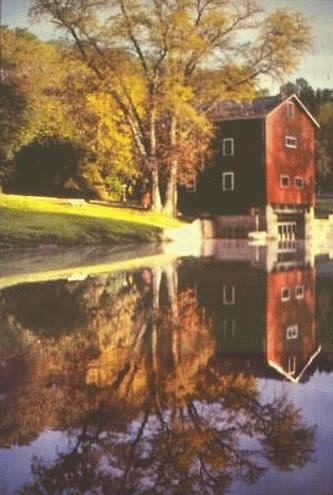
Indian Mill
Wyandot Co. | Ohio | USA
Watersource: Sandusky River.
Indian Mill
From US 30 east of Upper Sandusky, Ohio go north on US 23 Bypass for 2 miles, turn right on Old Mill Road/Sh 50 for 1 mile. Continue straight at junction with Sh 47/Sh 50. Go about .20 mile and turn right on Sh 47G. Mill and Sandusky River are straight ahead on the west side of the river.

The original one-story mill was built in 1820-21 by the United States Government with Charles B. Garret installed as the government miller. The Wyandot Indians were being rewarded for their help against the British in the War of 1812. The gristmill, operating with an undershot water wheel, functioned actively every harvest time. Jonathan Briley succeeded Garret as miller in 1834.

The current Indian Mill was built 250'-300' downstream from the original along the Sandusky River. The construction incorporated some of the still good black walnut timbers that were used in the first mill, which was disassembled in the process. The mill on site today was built in 1861 by Lewis Rummel who had also is credited with building the Rummel Mill in Ohio, Richland County. The construction of this mill is unusual. The framwork is almost like that of certain covered bridge construction, using wooden pegs with mortise and tendons at beam intersections. Huge black walnut and oak timbers were cut on an up-and-down saw mill and three Leffel turbines were installed in 1862 to power the mill apparatus.

Under Rummel, the mill was still government operated; but, in 1848 the mill was aquired by George Myers from the government. In 1865, David Maxwell was the owner/operator and in 1872, the reins had been turned over to Isaac Mann. Mann operated the mill until 1885, when he sold to John Finkle. The Sandusky River was quite adequate to turn these turbines to grind flour and cornmeal until the level of water in the river at the mill dropped about 1885. Therafter, the water power was sufficient to grind cornmeal only.

John Finkle's purchase of the the mill and two acres for $2,000 preceded his giving it to his son in 1920. Cornmeal was ground until 1943, when he sold the mill to Ward Walton, who sold it to the State of Ohio. The Indian Mill has the distinction of being the first mill museum in a mill structure in the United States and was dedicated to such purpose by the Ohio Historical Society.